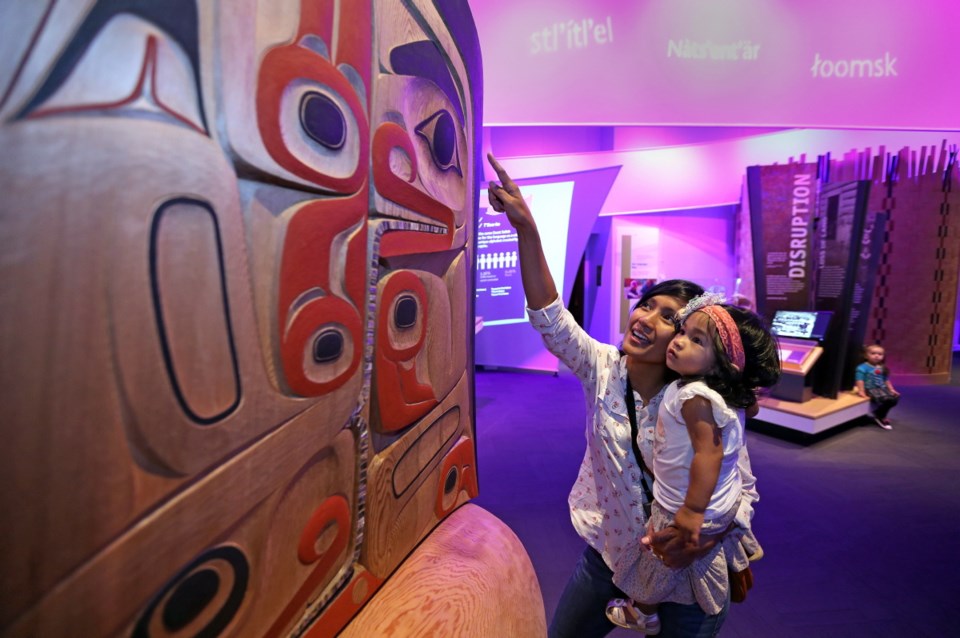First Nations and the Royal B.C. Museum have bridged the senses of sight and sound to create an exhibition based on spoken culture rather than artifacts.
The new exhibit, Our Living Languages: First Peoples’ Voices in B.C., is the end result of a collaboration between First Nations cultural experts and museum curators. It officially opens Saturday and will be at the museum for three years.
The museum offered its space and designers. First Nations collected and offered their knowledge and memories to supply the content.
The result is an exhibit that immerses visitors in the languages of the original peoples of the province, combining art pieces and artifacts with interactive maps, button-activated loudspeakers featuring recorded voices and film.
One of the centrepieces is a cradleboard, a type of infant-carrier. Over a speaker, visitors can hear recordings of mothers singing and talking to cooing babies.
Organizers of Our Living Languages said B.C. is the most linguistically rich province in Canada: There are 61 dialects of 34 languages — accounting for about 60 per cent of Canada’s First Nations languages — though the number of people who can speak them is dwindling.
According to a 2010 report on the status of B.C. First Nations languages, only 5.1 per cent of the aboriginal population — mostly elders — are able to speak their languages fluently.
Historical experiences such as residential schools and the exclusion of First Nations languages from government, media and education have almost wiped out many First Nations languages.
But Mike Willie, a member of the Musgamaw Dzawada’enuxw First Nation and a speaker and teacher of the Kwak’wala language, said he is optimistic they can be revived.
“I think there is enough passion and spirit to carry it through,” said Willie, at the museum Thursday for a media tour.
He said children — and not only First Nations children — are attending language classes at his school in Port Hardy. Between the drumming, the songs and the stories, the spoken word is catching on.
Willie, who is originally from Kingcome Inlet, said language reveals how we approach the world.
For example, Willie characterized English as noun-heavy, based on words for things or objects. He said many elderly speakers of First Nations languages complain it is dull and lifeless, incapable of even giving full breadth to a joke.
His own language, on the other hand, is based more on verbs, words that depict actions. For example, in Kwak’wala the word for child translates as “my reason for breathing,” while a marriage proposal translates as “will you share the same breath?”
Language also contains insights into how people feel about the land, the rivers and the oceans, the whole environment.
John Elliott, of the Tsartlip First Nation, said the Sencoten word for the Earth translates as “my wish,” with the possessive referring to the creator of all things. A mountain is “my gift” and islands are “my relatives of the deep,” and in stories people, were instructed to care for these relatives.
“To us, it’s not just a language — it’s a belief system of how we should live in the world.”
Tracey Herbert, executive director of the B.C. First Peoples’ Cultural Council and a member of the St’uxwtews First Nation near Cache Creek, said for First Nations people, words for “poverty” can be translated as “no access to salmon.”
Herbert, a key mover behind Our Living Languages, said new attempts to revive languages make use of the Internet and other technologies.
“We are trying to make languages accessible because 60 per cent of [aboriginal people] live off reserve,” she said. “And most of us don’t even have speakers of our languages in our families anymore.”
Jack Lohman, CEO of the museum, said the exhibit was a challenge for traditional-minded museum thinkers. “It sort of takes us away from our glass cabinets with our rows of specimens.”
But he is proud of the result, saying it gives visitors a chance to experience a vital aspect of First Nations cultures, which remain very much alive and part of our communities. “And where else can we learn about these things other than our own cultural institutions like our museums.”



